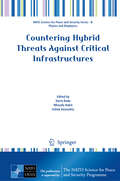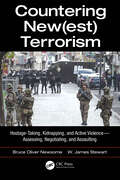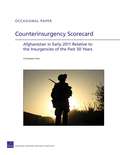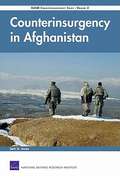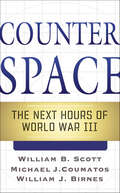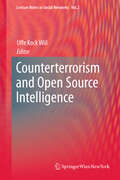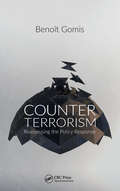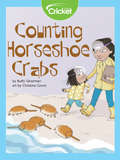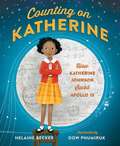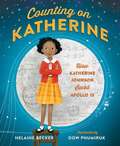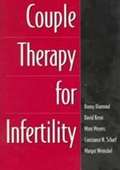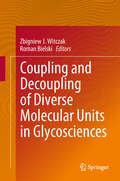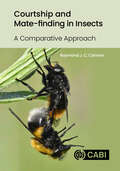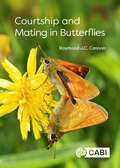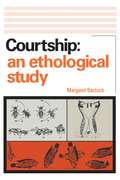- Table View
- List View
Countering Hybrid Threats Against Critical Infrastructures (NATO Science for Peace and Security Series B: Physics and Biophysics)
by Ashok Vaseashta Dorin Radu Mirsada HukićThis proceedings volume presents a collection of articles from key practitioners from relevant areas with experience in critical infrastructure. The authors acknowledge that the responsibility for critical infrastructure protection is primarily a matter of international importance, hence a high degree of cross-border and cross-sectoral interdependencies must be coordinated or, where appropriate, legally harmonized efforts at the international level, including the smooth functioning of the internal policies. The book focuses on countering hybrid threats that render critical infrastructures vulnerable. An understanding of such threats will render critical infrastructure safe, secure, and resilient. The protection of national critical infrastructures, as well as of the functions and services critical to the proper functioning of society is a key priority and requires a new unique and strategic approach. Work in this direction must consider the strong interdependencies between the various critical functions and services, including financial services, the key role of the private sector, the changing security environment, and emerging risks, both in the physical and cyber fields. In addition to legal requirements, agreements should be promoted with private sector infrastructure and service owners and operators to ensure the continuity of and access to critical services, including beyond force majeure, by ensuring an acceptable level of preparedness to respond. all relevant threats, as well as the flexibility to address and mitigate the effects of low-probability, high-impact events.
Countering New(est) Terrorism: Hostage-Taking, Kidnapping, and Active Violence — Assessing, Negotiating, and Assaulting
by Bruce Oliver Newsome James W. StewartHow should we analyze and assess new terrorist behaviors? What are the particular risks and challenges from new terrorism? Should we negotiate with terrorists, and, if so, how? When should we use force against terrorists? Countering New(est) Terrorism: Hostage-Taking, Kidnapping, and Active Violence—Assessing, Negotiating, and Assaulting improves our knowledge of new terrorist behaviors, and our skills in responding to such attacks.The term "new terrorism" has been in circulation since the late 90’s. This book analyzes the "newest terrorism" that has emerged in recent years—characterized by increased hostage-taking, kidnapping, and active violence—and develops best practices for countering these emerging threats. Along the way, it challenges fashionable wishful thinking that all terrorists are open to rational negotiation or de-radicalization, that military responses always reflect badly on the official side, and that terrorists are not constrained by their own doctrines.The new terrorists are dramatically more ideological, murderous, and suicidal. They are generally less reconcilable, less trusting of official negotiators, less likely to release detainees, and more likely to kill detainees. They are less likely to demand ransoms yet more likely to release hostages in cases in which they do demand ransom. They are more informed about the official side’s policies, tactics, techniques, and procedures. They are more likely to use new information and communication technologies against responding agencies and officials. They are more capable fighters—they kill more people despite deploying fewer fighters per hostage. Most disturbing is the fact that they take advantage of free-er societies to access easier targets. Features: Includes evidence-based definitions and descriptions of political, religious, Jihadi, and new terrorism Presents the first large-n comparison of old and new terrorism, using an original extension of the Global Terrorism Database (GTD), with added codes for each of 10,735 hostage crises and more than 500,000 data points from 1970 through 2016 Details a further extension of the GTD covering all terrorist events from 2004 through 2016, roughly 5 million data points. Offers prescriptive advice and visual decision trees on how to negotiate crises, assess the risk of terrorism, and how and when to assault terrorists Reviews official practices, interviews with experienced officials, and real-world simulations of recent terrorist events and attacks Countering New(est) Terrorism will be of interest to researchers, students enrolled in terrorism and Homeland Security programs, crisis negotiators, and police, security, intelligence, and military authorities tasked with counterterrorism and anti-terrorism efforts.
Countering Terrorism and WMD: Creating a Global Counter-Terrorism Network (Political Violence)
by Peter Katona Michael D. Intriligator John P. SullivanThis volume shows us that in order to deal with today’s Fourth Generation asymmetric warfare by terrorist groups using conventional arms and weapons of mass destruction, we need a new ‘global networked’ approach. The contributors examine the various attempts that have been made to counter the latest wave of terrorism, including the US strikes against Afghanistan and Iraq, President George W. Bush's declaration of a ‘war against terrorism’, the creation of the US Department of Homeland Security, and the 9/11 Commission. Drawing from our experience with ‘Terrorism Early Warning’ and the co-production of counter-terrorism intelligence, this book explains the need for such a network and shows how it could be formed. It compiles the opinions of experts from clinical medicine, public policy, law enforcement and the military. These expert contributors identify the nature of a global counter-terrorism network, show how it could be created, and provide clear guidelines for gauging its future effectiveness. This book will be of great interest to all students of terrorism studies, US national security, international relations, and political science in general.
Counterinsurgency Field Manual
by The U.S. Army Marine CorpsWhen the U.S. military invaded Iraq, it lacked a common understanding of the problems inherent in counterinsurgency campaigns. It had neither studied them, nor developed doctrine and tactics to deal with them. It is fair to say that in 2003, most Army officers knew more about the U.S. Civil War than they did about counterinsurgency.The U.S. Army / Marine Corps Counterinsurgency Field Manual was written to fill that void. The result of unprecedented collaboration among top U.S. military experts, scholars, and practitioners in the field, the manual espouses an approach to combat that emphasizes constant adaptation and learning, the importance of decentralized decision-making, the need to understand local politics and customs, and the key role of intelligence in winning the support of the population. The manual also emphasizes the paradoxical and often counterintuitive nature of counterinsurgency operations: sometimes the more you protect your forces, the less secure you are; sometimes the more force you use, the less effective it is; sometimes doing nothing is the best reaction. An new introduction by Sarah Sewall, director of the Carr Center for Human Rights Policy at Harvard’s Kennedy School of Government, places the manual in critical and historical perspective, explaining the significance and potential impact of this revolutionary challenge to conventional U.S. military doctrine. An attempt by our military to redefine itself in the aftermath of 9/11 and the new world of international terrorism, The U.S. Army / Marine Corps Counterinsurgency Field Manual will play a vital role in American military campaigns for years to come. The University of Chicago Press will donate a portion of the proceeds from this book to the Fisher House Foundation, a private-public partnership that supports the families of America’s injured servicemen. To learn more about the Fisher House Foundation, visit www.fisherhouse.org.
Counterinsurgency Scorecard: Afghanistan In Early 2011 Relative to the Insurgencies of the Past 30 Years
by Christopher PaulA core finding of previous RAND research on 30 years of insurgencies worldwide was that a conflict's overall score on a scorecard of 15 equally weighted good and 12 equally weighted bad counterinsurgency factors and practices perfectly predicted the ultimate outcome. Using the scorecard approach and an expert elicitation (Delphi) exercise, a RAND project sought to extend the findings to the case of Afghanistan in early 2011.
Counterinsurgency in Afghanistan: Rand Counterinsurgency Study
by Seth G. JonesThis study explores the nature of the insurgency in Afghanistan, the key challenges and successes of the U.S.-led counterinsurgency campaign, and the capabilities necessary to wage effective counterinsurgency operations. By examining the key lessons from all insurgencies since World War II, it finds that most policymakers repeatedly underestimate the importance of indigenous actors to counterinsurgency efforts. The U.S. should focus its resources on helping improve the capacity of the indigenous government and indigenous security forces to wage counterinsurgency. It has not always done this well. The U.S. military-along with U.S. civilian agencies and other coalition partners-is more likely to be successful in counterinsurgency warfare the more capable and legitimate the indigenous security forces (especially the police), the better the governance capacity of the local state, and the less external support that insurgents receive.
Counterinsurgency in Modern Warfare
by Daniel Marston Carter MalkasianThrough history armies of occupation and civil power have been repeatedly faced with the challenges of insurgency. US involvement in Iraq and Afghanistan has highlighted this form of conflict in the modern world. Armies, sometimes reluctantly, have had to adopt new doctrines and tactics to deal with the problems of insurgency and diverse counterinsurgency strategies have been developed. These have ranged from conventional military operations to a combination of military and political strategy including propaganda, Psy-Ops, and other approaches. In Counterinsurgency in Modern Warfare 13 contributors examine developments in counterinsurgency from the early 20th century to the present. Each author, an expert in his field, discusses in depth the conduct and outcomes of operations across the globe, including the Arab-Israeli conflict, Afghanistan and Iraq, and draws out the lessons to be learned from them. This book is a timely, serious yet accessible survey of a critical facet of modern warfare and present-day global conflict.
Counterspace: The Next Hours of World War III
by William J. Birnes William B. Scott Michael J. Coumatos“Takes us to the front lines of the space- and cyber-security world. A must-read to preview how our national-security future will unfold!” —Gen. Richard B. Myers (USAF-Ret.), former Chairman, Joint Chiefs of StaffIn Space Wars, Scott, Coumatos, and Birnes created a fascinating war gaming scenario of how World War III might unfold above the Earth’s surface. Now this thrilling team of writers reunites with Counterspace, an even more chilling fictionalized look at America’s most catastrophic fears.What if North Korea detonated a nuclear weapon in space and silenced dozens of satellites?What if an Iranian missile threatened to destroy Israel, while a Venezuelan “research” satellite endangered one of the US’s most promising space initiatives?What if tech-savvy terrorist cells unleashed back-to-back horrors in California, creating an avalanche of crises overnight, as national leaders robbed of spy satellite imagery were forced to make decisions in the “blind?”These are the scenarios of Counterspace, a frighteningly plausible look at threats to the United States and the world. Scott, Coumatos, and Birnes use war gaming scenarios to show how the US Strategic Command might choose to fight off these menaces and prevent global disaster. Combining current and future technology with our enemies’ grandest plans, Counterspace is equally a terrifying possibility and a hopeful affirmation that America can and will be ready to face such dangers, told with the pulse-pounding power of a modern-day thriller.“A page-turning techno-thriller . . . the story reads like today’s headlines, faithfully taking the reader inside the minds of madmen, heroes and space warriors.” —Elliot Holokauahi Pulham, Chief Executive Officer, The Space Foundation
Counterterrorism and Open Source Intelligence (Lecture Notes in Social Networks #2)
by Uffe WiilSince the 9/11 terrorist attacks in the United States, serious concerns were raised on domestic and international security issues. Consequently, there has been considerable interest recently in technological strategies and resources to counter acts of terrorism. In this context, this book provides a state-of-the-art survey of the most recent advances in the field of counterterrorism and open source intelligence, demonstrating how various existing as well as novel tools and techniques can be applied in combating covert terrorist networks. A particular focus will be on future challenges of open source intelligence and perspectives on how to effectively operate in order to prevent terrorist activities.
Counterterrorism: Reassessing the Policy Response
by Benoît GomisCounterterrorism: Reassessing the Policy Response promotes a more nuanced understanding of the effectiveness of current counterterrorism practices and the need for reform. It challenges government, media, and academic accounts that exaggerate terrorist threats, particularly in comparison to other threats such as organized crime. Author Beno�Gomis r
Counting Horseshoe Crabs
by Buffy SilvermanJenny has read all about horseshoe crabs and is excited to visit the beach and count them with her mom. By counting the horseshoe crabs, Jenny is helping scientists to protect the crabs that are migrating. She learns how the horseshoe crab migration can even benefit migrating shorebirds. When Jenny grows up, she definitely wants to be a scientist!
Counting on Katherine: How Katherine Johnson Saved Apollo 13
by Helaine BeckerThe story of Katherine Johnson whose contributions were crucial to the America's space program.
Counting on Katherine: How Katherine Johnson Saved Apollo 13
by Helaine BeckerThe bold story of Katherine Johnson, an African-American mathematician who worked for NASA during the space race and was depicted in the film Hidden Figures.You've likely heard of the historic Apollo 13 moon landing. But do you know about the mathematical genius who made sure that Apollo 13 returned safely home? As a child, Katherine Johnson loved to count. She counted the steps on the road, the number of dishes and spoons she washed in the kitchen sink, everything! Boundless, curious, and excited by calculations, young Katherine longed to know as much as she could about math, about the universe. From Katherine's early beginnings as a gifted student to her heroic accomplishments as a prominent mathematician at NASA, Counting on Katherine is the story of a groundbreaking American woman who not only calculated the course of moon landings but, in turn, saved lives and made enormous contributions to history.Christy Ottaviano Books
Couple Therapy for Infertility
by Ronny Diamond David Kezur Mimi Meyers Constance N. Scharf Margot WeinshelExamines the experiences of couples who are unable to conceive children and looks at possibilities for them.
Coupled CFD-DEM Modeling: Formulation, Implementation and Application to Multiphase Flows
by Hamid Reza Norouzi Navid Mostoufi Rahmat Sotudeh-Gharebagh Reza ZarghamiDiscusses the CFD-DEM method of modeling which combines both the Discrete Element Method and Computational Fluid Dynamics to simulate fluid-particle interactions. Deals with both theoretical and practical concepts of CFD-DEM, its numerical implementation accompanied by a hands-on numerical code in FORTRAN Gives examples of industrial applications
Coupled Dynamics in Soil: Experimental and Numerical Studies of Energy, Momentum and Mass Transfer (Springer Theses)
by Yijian ZengIn arid and semi-arid areas, the main contributions to land surface processes are precipitation, surface evaporation and surface energy balancing. In the close-to-surface layer and root-zone layer, vapor flux is the dominant flux controlling these processes - process which, in turn, influence the local climate pattern and the local ecosystem. The work reported in this thesis attempts to understand how the soil airflow affects the vapor transport during evaporation processes, by using a two-phase heat and mass transfer model. The necessity of including the airflow mechanism in land surface process studies is discussed and highlighted.
Coupled Heat and Mass Transfer in Binary Mixtures at Supercritical Pressures (Springer Theses)
by Zhan-Chao HuSupercritical pressure fluids have been exploited in many engineering fields, where binary mixtures are frequently encountered. This book focuses on the coupled heat and mass transfer in them, where the coupling comes from cross-diffusion effects (i.e., Soret and Dufour effects) and temperature-dependent boundary reactions. Under this configuration, three main topics are discussed: relaxation and diffusion problems, hydrodynamic stability, and convective heat and mass transfer. This book reports a series of new phenomena, novel mechanisms, and an innovative engineering design in hydrodynamics and transport phenomena of binary mixtures at supercritical pressures. This book covers not only current research progress but also basic knowledge and background. It is very friendly to readers new to this field, especially graduate students without a deep theoretical background.
Coupled Thermo-Hydro-Mechanical-Chemical Processes in Fractured Rocks: Fundamentals, Modeling and Applications
by Zhihong ZhaoThis book presents the coupled Thermo-Hydro-Mechanical-Chemical (THMC) processes in fractured rocks at varying scales from single fractures to fracture networks. It also discussed the implication and potential application of the advanced understanding of coupled THMC processes in fractured rocks for geotechnical and geo-energy engineering.
Coupling and Decoupling of Diverse Molecular Units in Glycosciences
by Zbigniew J. Witczak Roman BielskiThis unique book covers the latest developments in coupling and decoupling of biomolecules containing functionalized carbohydrate components, being one of the first collections in this important area of applied medicinal chemistry. Connecting molecules, often referred as bio-conjugation, has become one of the most often performed procedures in modern medicinal chemistry. Sometimes, when the connected molecules are not useful anymore, they must be disconnected. The molecules that must be connected (coupled) may belong to both small and large molecules and include such constructs as glycoproteins, glycopeptides and glycans. In this work, more than 15 experts address a comprehensive range of potential and current uses of in vitro and in vivo bio-conjugation methodologies, leading to a variety of glycoconjugates. The analytical aspects of bio-conjugation are also here discussed. Medicinal and organic chemists from graduate level onwards will understand the appeal of this important book.
Couplings and Joints: Design, Selection & Application (Mechanical Engineering)
by Jon R. Mancuso"Second Edition provides new material on coupling ratings, general purpose couplings versus special purpose couplings, retrofitting of lubricated couplings to nonlubricated couplings, torsional damping couplings, torquemeter couplings, and more."
Course Lab Manual: BI 101 Worcester State University
by Mcgraw-Hill EducationConcepts of Biology Lab Manual
Court-Ordered Insanity: Interpretive Practice and Involuntary Commitment (Social Problems And Social Issues Ser.)
by James A. HolsteinThis book, about involuntary commitment proceedings, focuses on interpretive practice at the nexus of legal, psychiatric, and practical reasoning. It describes the interactional dynamics through which legally and psychiatrically warranted decisions are publicly argued, negotiated, and justified.
Courtship and Mate-finding in Insects: A Comparative Approach
by Raymond J CannonThis book explores mate-finding and courtship behaviour in the insect world, in all its subtlety and diversity. Insects engage in courtship as much, or as little, as any other animal; they have songs and dances, and all manner of instruments and ornaments to attract and court the opposite sex. Insects have evolved complex chemical and acoustic communication systems, sending fragrant messages, visual signals and subtle vibrations to attract and persuade. Insects also have many different ways and means of choosing or rejecting mating partners. This beautifully illustrated book shows the incredible variety of courtship behaviours and celebrates the wonderful natural history of a wide range of insects. Varieties of courtship can occur before, during and even after copulation, and numerous examples of the different mating strategies used are presented. As well as being fascinating and entertaining, studying courtship is also useful. For example, a knowledge of the courtship and mating behaviour of important pests helps researchers understand the dynamics of mate choice and sexual selection. Knowing which behaviours are directly related with mating success can be used to improve behaviour-based control strategies and improve sterile insect techniques. Knowledge of sex pheromones, and mating behaviour, can be combined to manage insect pests by mass or mating disruption. By studying model species - such as the fruit fly, Drosophila melanogaster - researchers have discovered how genes control and influence courtship behaviour, via proteins, biochemical pathways and neural circuits. This book integrates these diverse fields into a framework constructed around courtship and mate-finding, bringing together studies from the laboratory and the field. This landmark volume will be of interest to students of biology, entomologists, naturalists and anyone with a desire to know more about the love lives of the small creatures with which we share the planet.
Courtship and Mating in Butterflies
by Raymond J.C. CannonThis book presents a readable account of butterfly behaviour, based on field observations, great photographs and the latest research. The main focus is on courtship and mating - including perching, searching and territorial behaviour - but to understand these subjects it is necessary to explain how mates are chosen and this requires sections on wing colours and patterns. A chapter on butterfly vision is also essential in terms of how butterflies see the world and each other. There have been exciting discoveries in all of these fields in recent years, including: butterfly vision (butterfly photoreceptors), wing patterns (molecular biology), wing colouration (structural colours and nano-architecture), mating strategies and female choice (ecology and behaviour).
Courtship: An Ethological Study
by Margaret BastockThis concise but thorough study of courtship behavior in fish, birds, and arthropods is the first rigorous examination of the evolutionary origins and mechanisms of courtship and its contribution to biological success. Demonstrating the fruitfulness of an empirically based, inductive approach to understanding courtship, the book also explains clearly how principles of modern evolutionary theory can be successfully employed in studying behavior.The author describes many observations and experiments that have not previously appeared outside specialized journals and brings an abundance of simple yet accurate examples of animal behavior to bear on explanations of ethological concepts and evolutionary theory. No attempt is made to skim over the gaps of knowledge apparent in the study of behavior evolution; rather, the author discusses the limitations and difficulties of different approaches, critically reviews the deductions that can be and have been made from them, and tries to present enough evidence on controversial points for the reader himself to judge the validity of specific arguments.Indicating how ethological method, firmly based on biological principles, can intensively investigate and illuminate a single area of animal behavior, the book will be valuable to students and professionals in zoology, animal behavior, and experimental psychology.
